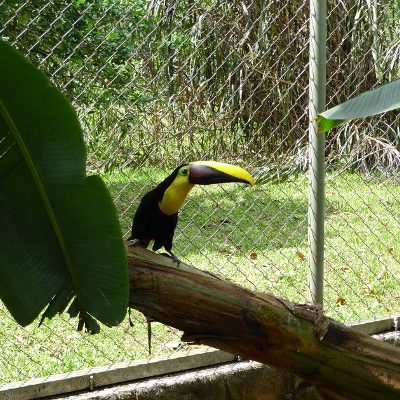The toucan is often referred to as the most romantic bird in the animal kingdom. They play, they flirt, they dote, they groom, and mates will possessively feed each other from their colourful beak. Pairs will stay together until their babies are old enough to fly on their own.
In Costa Rica there are six different species of Toucan and the biggest threat to their existence is deforestation because their only source of protection from predators is hiding in the canopy and burrowing themselves into trees.
The toucan’s relationship with the trees is rather symbiotic. The rainforest provides toucans with protection, in return the bird spreads fruit seeds, which seem to pass through their stomachs untouched to sprout new trees.
When at Rincón de la Vieja we found ourselves at a toucan rescue that housed two birds. The permanent Wildlife Rescue Center was under construction and these two were in their temporary home.
The first bird we met was this extremely vocal bird who chatted the entire time we were in the enclosure. It’s a chestnut-mandibled Toucan and is not commonly found in Guanacaste or Rincón de la Vieja. This bird was a pet that was abandoned and unable to live in the wild.
Also is a Keel-Billed Toucan that came to the rescue with no feathers or ability to fly. After months of rehabilitation and care, it’s learning to socialize.
La Niña was asked to help give it some food. At first she was a little nervous of it’s powerful looking beak and was afraid it would snatch her fingers. But the bird demonstrated just how gentle it was and how deftly it could take food from between two fingers. She also discovered that even though the beak looks ominous, it’s rather light and agile.
We can now add the toucan to the ever growing list of animals La Niña wants to help. She would like me to add that it’s illegal to hunt a toucan for meat, feathers, and for the pet trade.






Another cause for Niña.